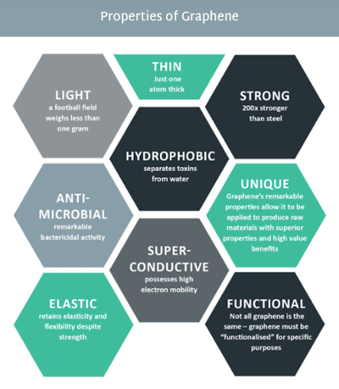Sparc’s focus sets it apart in realising graphene’s incredible value

Pic: Morsa Images / DigitalVision via Getty Images
The 2004 discovery of graphene – the atom-thick, incredibly strong and light material with graphite origins – was significant enough an achievement that those who found it were awarded the 2010 Nobel Prize in Physics.
“Graphene is a form of carbon. As a material it is completely new – not only the thinnest ever but also the strongest,” the 2010 Nobel Prize press release announcing the result declared.
“As a conductor of electricity it performs as well as copper. As a conductor of heat it outperforms all other known materials. It is almost completely transparent, yet so dense that not even helium, the smallest gas atom, can pass through it.
“Carbon, the basis of all known life on earth, has surprised us one again.”
Clearly graphene’s discovery and its incredible scientific properties were the cause of much excitement at the turn of the last decade. If the quote above didn’t quite capture the potential, the chart below should.

An atom-thick lattice with unique and powerful potential, the challenge for those in the graphene game over the years since has been in finding the best use of a material with such incredible attributes.
It’s one that newly appointed Sparc Technologies (ASX:SPN) CEO Mike Bartels recently explored with his team, as the company undertook a comprehensive review of business activities.
Sparc is a South Australian-based technology company focused on the development of innovative solutions which maximise the unique properties of graphene.
The company has licenced graphene-based technologies from the University of Adelaide, considered a leading institution in the field of research, and is focused on the commercialisation of graphene-based tech.
Bartels said because of the broad potential of the material and the positive results of the work done to date by Sparc, it was important to have a clear focus when it came to R&D, execution and commercialisation.
For this reason, Sparc has honed its attentions in on developing and commercialising graphene technologies on workstreams across three key areas. They are:
- Environment – Industrial Materials – Product Enhancement
- Sustainability and Remediation – Extraction
- Health – ‘living a better life’.
“Having identified a number of core market opportunities arising from the exceptional results established by our development activities, the company is now progressing from the R&D phase to engaging with potential customers,” Bartels said in a strategy note to market.
“Accordingly, we have now entered into a significant number of non-disclosure agreements with major industry players interested in potentially incorporating our graphene technology into their global products.
“As an example, Sparc is now working on twelve projects within the coatings enhancement work stream which targets niche markets that we believe can be fast-tracked to commercialisation.
“Against this backdrop and as a result of our strategic review, it is important that we provide this operational clarity to the market.”
Environmental – Industrial Materials – Product Enhancement Focus
On the industrial front, Sparc intends to optimise material performance through the addition of graphene-based products.
The technology platform being developed hones in on the ability to disperse ans stabilise graphene-based products, allowing them to be incorporated into a range of materials.
Activities at present are focused on:
- Coatings: 12 coatings projects are underway.
- Concrete: Developing in-house expertise and targeting niche applications.
- Composites: Looking at applying proprietary graphene dispersion techniques to enhance composites.
A number of specific programs testing coatings, including paints, are well advanced, and results from these programs are expected to be published in November 2021.
Earlier positive results from test programs have led Sparc to discuss further collaboration with domestic and international coatings companies.
Sparc believes its expertise in graphene-based products for coatings will eventually deliver coatings across a number of paint and coating categories, with 12 specific projects already recognised and work now underway.
Projects will span anticorrosive, antifouling, fireproofing, corrosion under insulation and antibacterial coating categories.
Meanwhile, a graphene additive product developed by Sparc is currently being evaluated by a major cement company under a non-disclosure agreement. More work has started on recognising applications within the broader cementitious product portfolio.
Testing is about to begin in the composites realm, with an industry partner and covered by a non-disclosure agreement.
Sustainability and Remediation – Extraction
This workstream will develop products which will serve to optimise or, where applicable, disrupt current industry practices around the extraction – most of which use activated carbon.
The technology platform being developed uses graphene-based products to optimise the extraction of targeted materials – under its agreement with the University of Adelaide, Sparc said it had developed an understanding of how to functionalise graphene and exploit its unique adsorbent characteristics.
These can be used to extract precious materials and for remediation purposes, with Sparc looking into two areas – tailings and PFAS (chemical compounds used in products to resist heat, oil, stains and water).
The tailings area is focused on research that shows graphene can be used to improve accepted industry extraction yields of precious and base metals – gold, silver and copper, as examples. Activities are currently focused on confirming test results with industry partners.
The results are similarly promising for PFAS, with University of Adelaide research showing graphene can be used to deliver exceptional results in the extraction of these materials from aqueous solutions.
Activities here are also focused on confirming these results with an industry partner.
Health – ‘living a better life’
An emerging field by comparison in the use of graphene tech and Sparc, the company is currently collaborating with several industry partners in different areas.
The company is developing technology for wearable graphene biosensors which will allow for remote, real time monitoring of health. It is also working on the enhancement of medical-grade materials through the deposition of graphene – enhancing properties that are of interest to established players in the health market.
This article was developed in collaboration with Sparc Technologies, a Stockhead advertiser at the time of publishing.
This article does not constitute financial product advice. You should consider obtaining independent advice before making any financial decisions.
Related Topics
UNLOCK INSIGHTS
Discover the untold stories of emerging ASX stocks.
Daily news and expert analysis, it's free to subscribe.
By proceeding, you confirm you understand that we handle personal information in accordance with our Privacy Policy.








